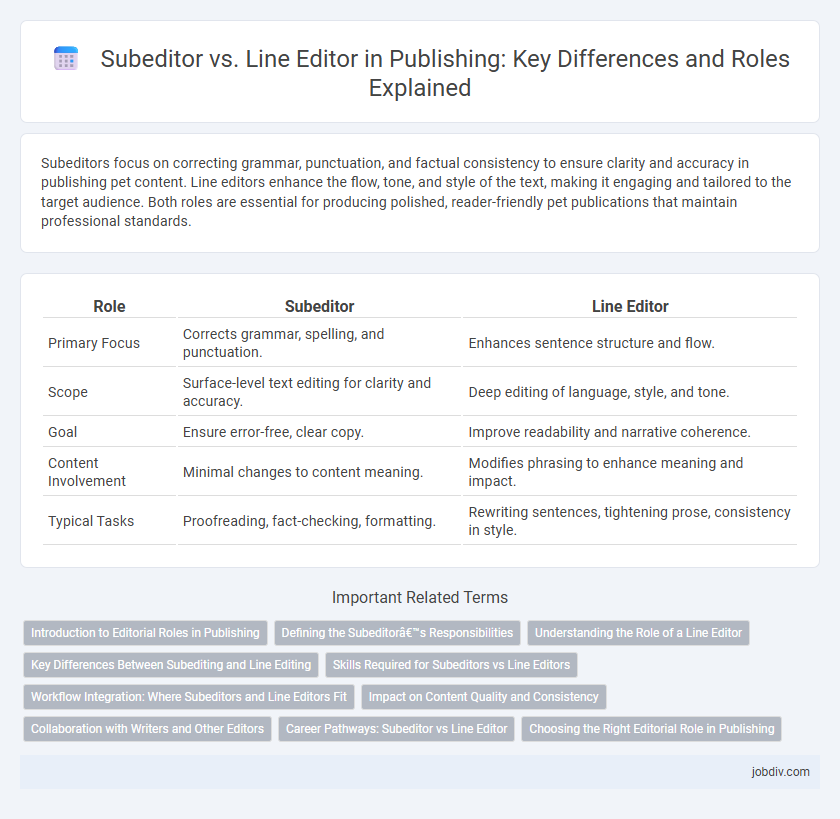Subeditors focus on correcting grammar, punctuation, and factual consistency to ensure clarity and accuracy in publishing pet content. Line editors enhance the flow, tone, and style of the text, making it engaging and tailored to the target audience. Both roles are essential for producing polished, reader-friendly pet publications that maintain professional standards.
Table of Comparison
| Role | Subeditor | Line Editor |
|---|---|---|
| Primary Focus | Corrects grammar, spelling, and punctuation. | Enhances sentence structure and flow. |
| Scope | Surface-level text editing for clarity and accuracy. | Deep editing of language, style, and tone. |
| Goal | Ensure error-free, clear copy. | Improve readability and narrative coherence. |
| Content Involvement | Minimal changes to content meaning. | Modifies phrasing to enhance meaning and impact. |
| Typical Tasks | Proofreading, fact-checking, formatting. | Rewriting sentences, tightening prose, consistency in style. |
Introduction to Editorial Roles in Publishing
A subeditor ensures clarity, accuracy, and consistency by refining grammar, style, and formatting in manuscripts, while a line editor focuses on improving sentence structure, flow, and readability at the paragraph and sentence level. Both roles are essential in publishing to enhance the quality and coherence of content before final publication. Understanding the distinct responsibilities of subeditors and line editors enables efficient collaboration in the editorial process.
Defining the Subeditor’s Responsibilities
The subeditor's responsibilities in publishing center on refining the manuscript for clarity, consistency, and style adherence, ensuring the text aligns with the publication's editorial standards. Key tasks include correcting grammar, punctuation, and spelling errors while fact-checking and verifying sources to maintain accuracy and credibility. Subeditors also format the layout and prepare copy for final production, balancing readability with the publication's tone and voice.
Understanding the Role of a Line Editor
A line editor specializes in refining the clarity, flow, and style of a manuscript at the sentence and paragraph level, ensuring each line effectively conveys the intended message. Unlike a subeditor who primarily focuses on factual accuracy, grammar, and adherence to house style, the line editor enhances narrative voice and consistency throughout the text. This role requires close attention to language nuances, pacing, and readability to elevate the overall quality of the published work.
Key Differences Between Subediting and Line Editing
Subediting primarily focuses on correcting grammar, punctuation, syntax, and fact-checking within a manuscript to ensure clarity and adherence to style guides, whereas line editing emphasizes enhancing sentence structure, flow, and tone to improve reader engagement. Subeditors refine the technical accuracy and consistency of the text, while line editors target the artistic and narrative quality, shaping the writer's voice and improving readability. Both roles are essential in the publishing process but address different layers of the manuscript to produce a polished and compelling final product.
Skills Required for Subeditors vs Line Editors
Subeditors require strong copyediting skills, including grammar, punctuation, and style consistency expertise, along with the ability to fact-check and ensure clarity in headlines and captions. Line editors need advanced language proficiency, a deep understanding of narrative flow, and the skill to enhance tone, voice, and pacing within the manuscript. Both roles demand meticulous attention to detail, but subeditors focus more on technical accuracy while line editors concentrate on improving the creative and structural aspects of the text.
Workflow Integration: Where Subeditors and Line Editors Fit
Subeditors primarily focus on finalizing content by correcting grammar, punctuation, and factual accuracy, integrating seamlessly at the end of the editorial workflow to ensure publication-ready text. Line editors concentrate on refining style, tone, and clarity during the drafting phase, working closely with writers to enhance narrative flow and coherence. Together, subeditors and line editors create a layered editorial process that balances detailed content polishing with overarching stylistic improvements for optimized publication quality.
Impact on Content Quality and Consistency
Subeditors enhance content quality by correcting grammar, punctuation, and style errors, ensuring consistency across the publication's language and formatting. Line editors improve the narrative flow and clarity at the sentence and paragraph level, refining tone and voice to align with the intended audience. Together, these roles significantly elevate the overall readability and professionalism of published materials.
Collaboration with Writers and Other Editors
Subeditors collaborate closely with writers by refining grammar, formatting, and style to ensure consistency and adherence to editorial guidelines, acting as a bridge between the manuscript and final publication. Line editors work alongside writers to enhance sentence flow, clarity, and tone, making the text engaging and polished while preserving the author's voice. Both roles coordinate with other editors and publishing teams to streamline revisions and maintain overall content quality throughout the editorial process.
Career Pathways: Subeditor vs Line Editor
Subeditors typically begin their careers by mastering copyediting skills, focusing on grammar, style, and fact-checking to ensure clarity and accuracy in manuscripts. Line editors often progress from roles such as subeditors or editorial assistants, emphasizing narrative flow, pacing, and sentence-level enhancements to improve readability and coherence. Career pathways in publishing for both positions involve increasing editorial responsibility, with subeditors advancing toward senior editing roles and line editors developing expertise in content structure and author collaboration.
Choosing the Right Editorial Role in Publishing
Subeditors focus on correcting grammar, punctuation, and factual accuracy to ensure clarity and consistency in the manuscript, while line editors concentrate on enhancing sentence structure, tone, and flow to improve readability and style. Choosing the right editorial role depends on the manuscript's current stage and specific needs, with subeditors suited for final polishing and line editors ideal for deep stylistic revisions. Understanding these distinct functions helps publishers allocate resources effectively for high-quality content production.
Subeditor vs Line Editor Infographic

 jobdiv.com
jobdiv.com